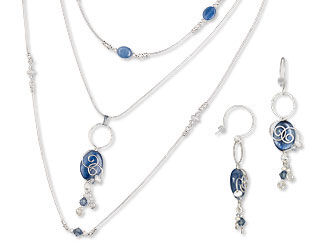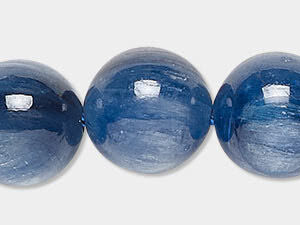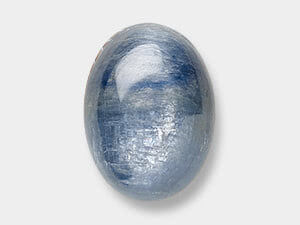Kyanite Meaning and Properties
Kyanite History
Named in 1789 by Abraham Werner, kyanite draws its identity from the Greek term κύανος (cyanos) (or "dark blue")—which this beautiful gemstone certainly is! Kyanite is one of the most attractive blue minerals in nature, sometimes exhibiting intense shades of blue, or even multiple shades with color zoning in a single crystal. The French spelling "cyanite" was common until the mid-20th century.
This andalusite relative—in its non-gemstone form—is used in ceramics, electronics, electrical insulators and abrasives. It forms under very specific metamorphic conditions, making it an "index mineral"—a material which helps geologists estimate the depth, temperature and pressure of its surrounding matrix.
What are the Metaphysical Properties of Kyanite?
Kyanite is strongly believed to facilitate meditation; some practitioners consider its meditative power to be one of its two defining features. The second is that they believe kyanite never needs to be cleansed of negative energies—because it cannot accumulate or retain them!
This gemstone is thought to align with all chakras automatically, like wi-fi that's perpetually on. Kyanite meaning is associated with stimulating communication, growing awareness of others, perseverance against challenges, promoting balance of female and male energies and much more!
Specific colors are said to have specialized abilities:
- Black: grounds the body by aligning all chakras simultaneously
- Blue: strengthens the voice, soothes the throat, useful for speakers and vocal performers
- Green: connects the heart to the third eye chakra to promote insight, increases connection to the natural world
- Orange: bolsters creativity, improves visualization and cleanses the aura
Kyanite meaning is affiliated with the zodiac signs Aries, Taurus and Libra and all chakras.
What is Kyanite Made From?
This attractive blue mineral often appears as large, well-formed bladed crystals, making it a popular material for gemological collectors and jewelry makers alike. Kyanite has an almost fibrous appearance, especially as stones are often left rough to prevent stone loss during polishing. This internal structure can encourage chatoyancy (the cat's eye effect), yet it prevents most asterism from forming in kyanite, even when cut into smooth cabochon forms. Kyanite rarely exhibits a single shade of color; color often shows as areas, zones or blotches for a dramatic appearance.
Kyanite is strongly anisotropic--it has a dual Mohs hardness depending on the angle the pressure comes from. In fact, it is the most commonly known anisotropic mineral! Its vertical hardness ranges from 4.5 to 5.5; its horizontal hardness ranges from 6 to 7.
Kyanite is found around the world, with major deposits found in Switzerland, Brazil, Russia, Kenya, Nepal, Tanzania and in the eastern United States. So-called "ruby in kyanite" (or "ruby in apatite") is a trade name for a blended stone material which may or may not contain kyanite (or apatite), depending on the stone matrix. This soft material is stabilized using a colorless resin.
- Mineral Information Aluminum silicate
- Chemical Composition Al2SiO5
- Color Most frequently light to dark indigo blue; far less common hues include yellow, white, grey, green, black or orange.
- Hardness 4-1/2 to 7 (Mohs)
- Specific Gravity 3.5 - 3.7
- Refractive Index 1.71 - 1.73
How Do You Clean Kyanite?
Kyanite is durable, but complicated. Remember those anisotropic properties? They can make kyanite a brittle stone, prone to splitting along its "grain." Don't ever put kyanite in steamers or ultrasonic cleaners, and avoid bleach and other household chemicals. Kyanite's subtle luster is sometimes enhanced by oils, which can affect gemstone care requirements. Clean the stone with a damp, soft cloth and pat dry. Store in a cloth bag.
Kyanite FAQ
Q: What causes kyanite’s signature blue color and sometimes green or black hues?
A: Iron and titanium are the source of the blue hue of kyanite. Other inclusions can cause kyanite to be different colors, such as manganese for orange kyanite, chromium or vanadium for green kyanite and graphite for black kyanite.
Q: Is kyanite treated or enhanced in any way?
A: Kyanite is a brittle and fragile stone that is sensitive to heat, so it is rarely treated. Some specimens may be stabilized with resin.
Q: What shapes and cuts best showcase kyanite’s beauty?
A: Due to its anisotropic qualities—varying hardness—kyanite is most successfully cut en cabochon. A very skilled gem cutter is needed to facet kyanite.
Q: Where is kyanite mined?
A: Major deposits of kyanite are found in Switzerland, Brazil, Russia, Kenya, Nepal, Tanzania and in the eastern United States, although it is sourced worldwide.
Designing with Kyanite
Kyanite's variable blue coloring and fibrous appearance make it an eye-catching stone for jewelry design. Jewelry makers can accent the range of blues by pairing it with sapphire, blue lace agate, blue fossil beads or various shapes and shades of Austrian crystal. The cool blues of the stone work well with gold, show beautifully with silver and contrast stunningly with copper and rose gold. Complementary hues of orange—such as carnelian, sunstone or coral—offer a dynamic alternative. See the color wheel for additional tips.
Kyanite's anisotropic properties can make it a fragile stone. It is best used as earrings or pendants, where it will be less likely to be scratched or subject to impact. When strung next to other gemstones, knotting is recommended to protect this stone from shearing or cleaving.
A Few Design Inspirations to Get You Started
Shop for Kyanite
**Please note that all metaphysical or healing properties listed are collected from various sources. This information is offered as a service and not meant to treat medical conditions. Fire Mountain Gems and Beads® does not guarantee the validity of any of these statements.
How did you like this resource? Your feedback helps us provide resources that matter to you most.
Copyright Permissions
All works of authorship (articles, videos, tutorials and other creative works) are from the Fire Mountain Gems and Beads® Collection, and permission to copy is granted for non-commercial educational purposes only. All other reproduction requires written permission. For more information, please email copyrightpermission@firemtn.com.





